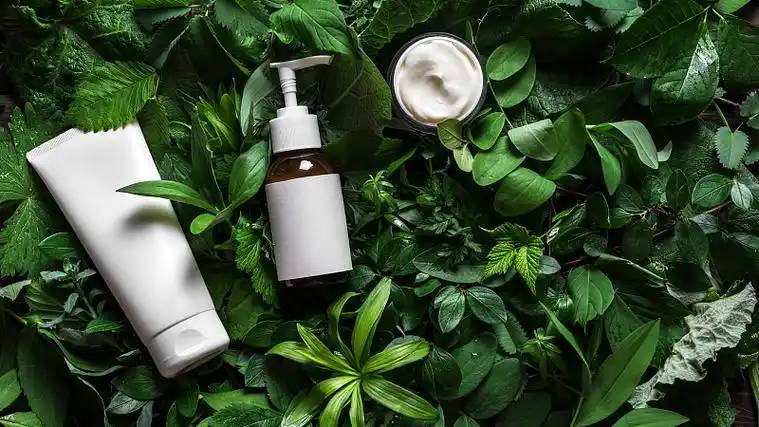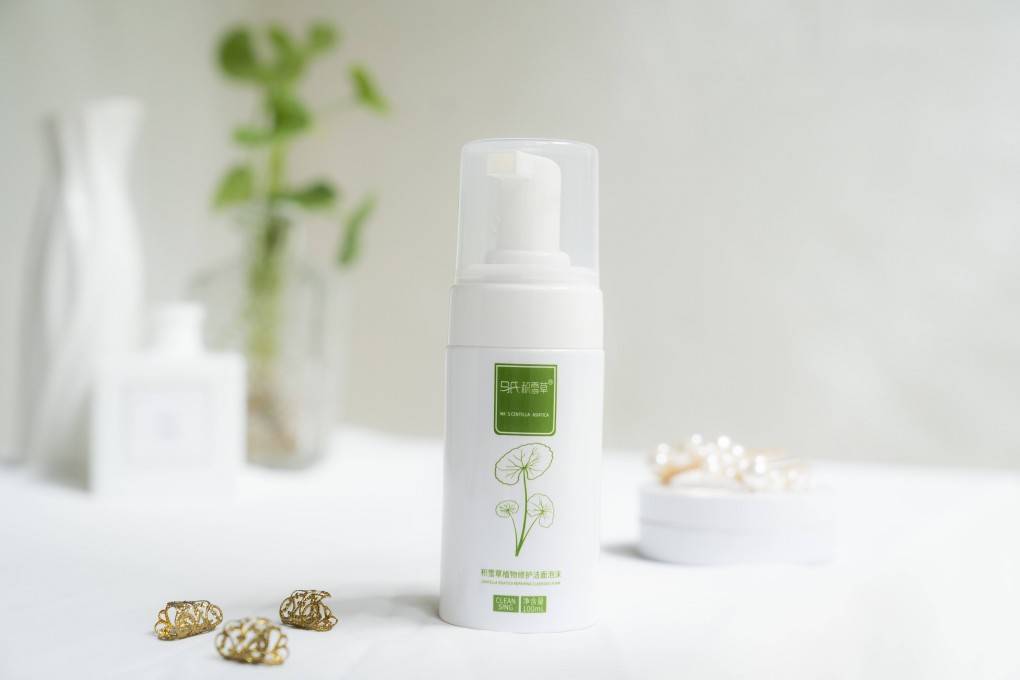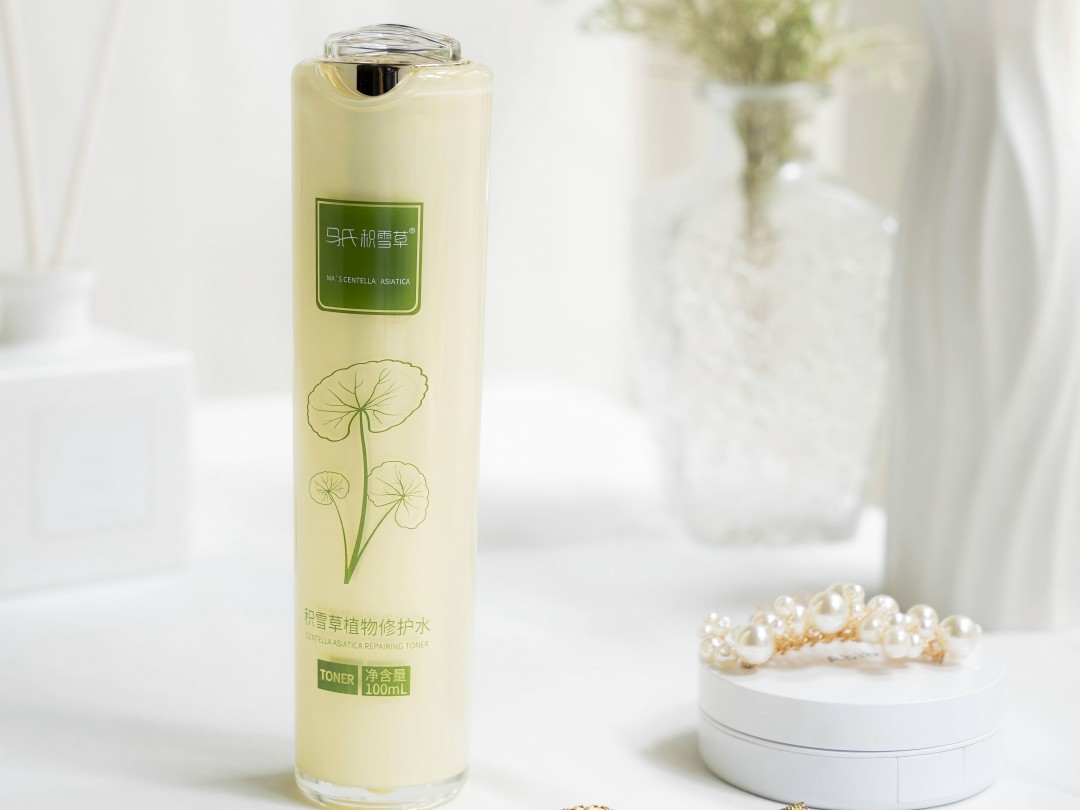Study on Centella Asiatica Leaf Extract Skin Benefits
Centella asiatica is a perennial herb in the Apiaceae family. It is a traditional Chinese medicine herb used in many Asian countries to treat various diseases. The earliest record of Centella asiatica in China can be traced back to Shennong's Classic of Materia Medica, which describes its nature and main indications as “bitter in taste, cold in nature. It is mainly used for treating severe fever, ulcers, carbuncles and boils, redness of the skin, and fever.” Modern pharmacological studies have shown that Centella asiatica and its extracts have pharmacological effects such as promoting wound healing, treating scars, antibacterial and antioxidant properties [1-3].
The main component of Centella asiatica extract is a pentacyclic triterpenoid compound. The most abundant bioactive substances with pharmacological effects include asiaticoside, madecassoside and their aglycones, asiatic acid and madecassic acid [1, 4]. Studies have reported that Centella asiatica and its related components have a therapeutic effect on acne, vitiligo, diabetic skin lesions, psoriasis, and are also beneficial for skin phototherapy post-operative repair, with a wide range of application prospects.

The components of Centella asiatica extract can accelerate the recovery of post-acne pigmentation, inhibit redness and blackening of the skin, and also play an antibacterial role [5]. For vitiligo, Centella asiatica extract has a therapeutic effect of reducing pigmentation. Nitric oxide gel containing asiaticoside can exert anti-inflammatory and endocrine regulating effects, and promote the healing of diabetic skin ulcers [6].
Centella asiatica has also been shown to have some anti-psoriatic effects [7-8]. Other studies have shown that during photodynamic therapy, centella asiatica extract has a positive effect on repair, moisture retention, and anti-inflammation [9]. This review summarizes the research on the pharmacological effects and mechanisms of centella asiatica extract on the skin. As the chemical components of Centella asiatica that exert pharmacological effects have been explained in the previous section, in the following narrative, Centella asiatica or Centella asiatica extract will be used to refer to the chemical components represented by asiaticoside, madecassoside, asiatic acid, madecassic acid, and other chemical components that have been extracted from Centella asiatica during research and development and have positive effects on human skin tissue.
1 Anti-inflammatory effect and mechanism
Centella asiatica extract has a certain inhibitory effect on inflammatory responses [10-11], so it has a certain therapeutic effect on atopic dermatitis, acne and other diseases related to inflammatory responses. The anti-inflammatory effect of Centella asiatica is related to its regulation of cell gene expression and its influence on the release of related cytokines. Some researchers have conducted studies based on a mouse model of phthalic anhydride-induced atopic dermatitis and RAW264. 7 mouse macrophages. The results show that the anti-oxidant and anti-inflammatory effects of Centella asiatica phospholipid complex are significant.
The anti-inflammatory mechanism is related to the inhibition of inducible nitric oxide synthase and cyclooxygenase 2 gene expression, activation of the nuclear factor (NF)-κB signaling pathway, upregulate extracellular regulated protein kinase phosphorylation, increase tumor necrosis factor (TNF)-α and interleukin (IL)-1β expression, promote IgE release, inhibit lipopolysaccharide-induced NO production, and inhibit the DNA binding activity of NF-κB [12]. Centella asiatica has the effect of treating atopic dermatitis [13]. It has also been found that madecassoside can significantly inhibit the nuclear translocation of pro-inflammatory cytokines IL-2β, Toll-like receptor 1 and NF-κB in THP-1 human monocytes stimulated by Propionibacterium acnes, reduce inflammatory responses, inhibit acne formation, and have high clinical value [14].
Meanwhile, the research of LEE et al. [13] also shows that Centella asiatica ethanol extract can inhibit inflammatory cytokines and reduce specific dermatitis-like skin inflammation. The mechanism is related to reducing immune cell infiltration, regulating the Th1/Th2 balance, and down-regulating the expression of IFN-γ/TNF-α in keratinocytes. Centella asiatica extract can also inhibit the expression of transforming growth factor (TGF)-β and reduce the release of mast cell-dependent inflammatory mediators, which has an anti-allergic effect. Other related studies have also reached similar conclusions: Centella asiatica extract can down-regulate the level of inflammatory factors [7, 15], inhibit skin inflammatory responses, and play an active role in the treatment of inflammatory and reactive skin diseases such as atopic dermatitis and acne.
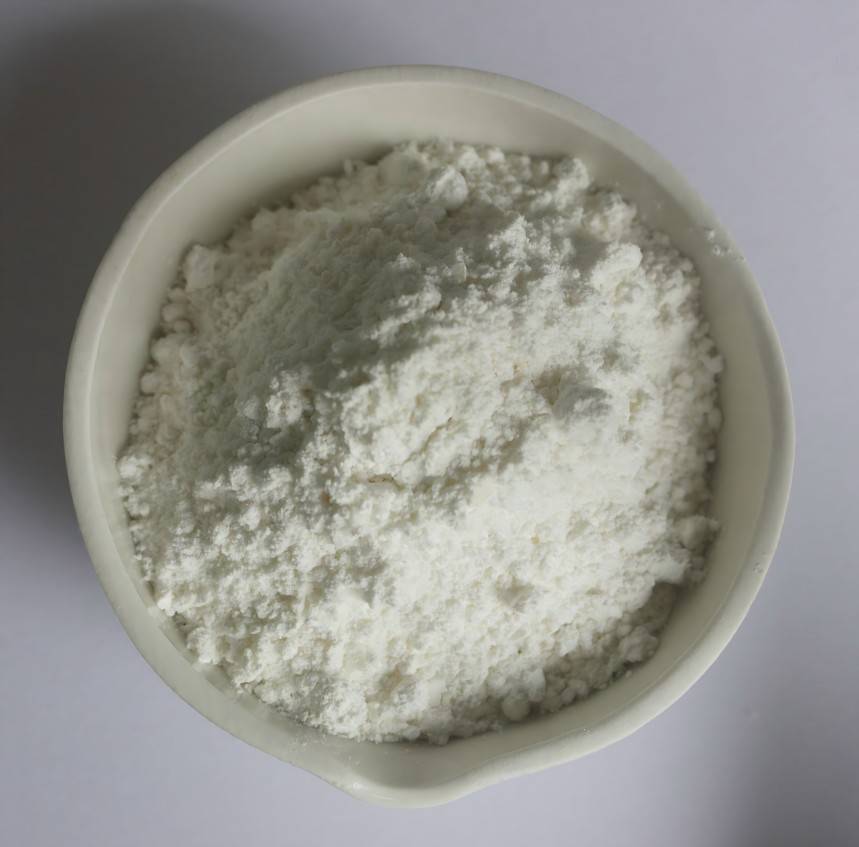
2. Promoting skin damage repair and its mechanism
Centella asiatica is considered an important medicinal plant for the treatment and relief of skin diseases and is beneficial for skin wound healing [16-17]. The results of a study on standardized Centella asiatica extract showed that it can enhance the migration of the human keratinocyte cell line HaCaT in a concentration- and time-dependent manner, upregulate Rac1 and RhoA gene expression, induce cell migration by activating the FAK, AKT, and MAPK signaling pathways, enhance the migration activity of human keratinocytes, and promote wound healing [18].
In addition, Centella asiatica extract may also promote skin wound healing by promoting collagen protein synthesis and other pathways. Previous studies have found that Centella asiatica extract promotes wound healing by promoting fibroblast proliferation and collagen synthesis in the early stages of repair, and exhibits certain antibacterial activity. The type of solvent used to extract Centella asiatica and the concentration of the extract also have a certain degree of effect on the healing of surgical skin damage. The wound-healing function of Centella asiatica extracts in different extraction solvents varies. Some scholars have found that Centella asiatica extracts in hexane, ethyl acetate, methanol and water all help to heal wounds in male SD rats, and that asiatic acid extracted from ethyl acetate may be the most active ingredient in healing wounds. According to some studies on cell proliferation and migration, low concentrations of Centella asiatica water extract may be more effective in promoting wound healing.

3 Anti-skin aging, antioxidant effects and mechanisms
Centella asiatica extract has antioxidant capacity and may be an ideal ingredient for anti-skin aging agents [19]. Regarding the specific mechanism of anti-aging of Centella asiatica extract, it has been found that 50% ethanol extract of Centella asiatica may inhibit oxidative damage and cell death by upregulating the activity of antioxidant enzymes and promoting the elimination of reactive oxygen species (ROS) by fibroblasts, thereby slowing down skin aging [20].
JIANG et al. [21] found that asiaticoside has a significant therapeutic effect on photoaging of the skin. First, the expression of matrix metalloproteinase 9 in HaCat cells treated with asiaticoside was significantly reduced, indicating that asiaticoside is a strong inhibitor of UV-induced ROS production. It delays UV-induced photoaging of dermal cells by scavenging excess intracellular ROS, and inhibits skin photoaging by affecting the TGF-β1/Smad signaling pathway to inhibit the expression of TGF-β1, Smad2 and Smad3. Some scholars believe that this effect is related to the high content of phenolic substances in Centella asiatica extract [22]. Secondly, the active ingredients in Centella asiatica may exert anti-aging effects by inhibiting collagen degradation. Yu Haiyuan [23] also found that madecassoside can inhibit collagen degradation by weakening the ROS/MAPK signaling pathway and reducing the expression of matrix metalloproteinase 1, providing ideas for clinical anti-aging.
The anti-aging function of Centella asiatica may also be related to regulating the length of telomeres in fibroblasts. Studies have found that a plant combination containing Centella asiatica extract significantly reversed the reduction in cell viability induced by H2O2 and reduced the rate of telomere shortening in stressed fibroblasts [24]. Under conditions of oxidative stress, compared with untreated fibroblasts, the telomere length of fibroblasts is more stable, the percentage of short telomeres is lower, and treatment with a plant combination containing Centella asiatica extract for 24 hours can transiently increase relative telomerase activity and inhibit the accumulation of UVR-induced glycation substances, demonstrating the effect of the ingredient in combating skin aging. In addition, Centella asiatica extract also has a certain effect on aging-induced periorbital wrinkles. One study looked at the effect of asiaticoside on the wrinkles around the eyes of 27 women. It was found that after 12 weeks of applying a cream containing asiaticoside to the skin around the eyes, the wrinkles around the eyes of most of the subjects were reduced to some extent, and the wrinkles around the eyes of some subjects improved significantly, suggesting that asiaticoside has a positive effect on reducing crow's feet.
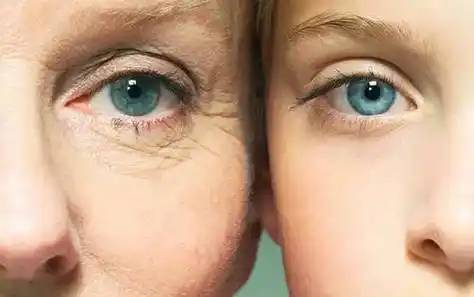
4. Improving skin barrier hydration and mechanism
A series of studies and reviews have shown that Centella asiatica extract not only has anti-inflammatory and anti-aging properties, but can also be used to improve skin barrier hydration [25-26]. SHEN et al. [14] showed that one of the main active ingredients in Centella asiatica, asiaticoside, can enhance skin hydration by increasing the expression of aquaporin 3 in HaCaT cells and promoting the secretion of hyaluronic acid in human dermal fibroblasts, it has the effect of enhancing skin hydration.
The results of an 8-week single-center clinical study on healthy female and male subjects aged 25 to 55 showed that compared with the moderate to severe facial dryness initially experienced by the subjects, the skin repair function and skin barrier hydration were significantly improved after using a face cream containing Centella asiatica extract [27]. Some researchers speculate that the above-mentioned effects of Centella asiatica may be related to the concentration of its extract. In-vivo testing of a formula containing 5% Centella asiatica extract found that it had the best effect on improving skin moisture by enhancing the hydration of the skin barrier and reducing transepidermal water loss.
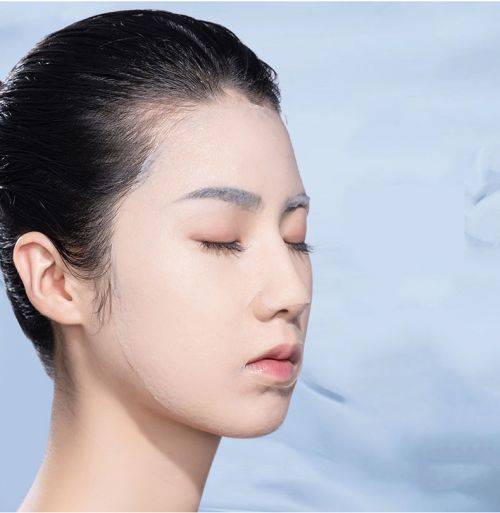
5. Effects and mechanisms of reducing pigmentation and improving skin vitality
Centella asiatica extract has the function of reducing skin pigmentation and improving skin vitality [28]. The results of a study by KIM et al. [29] showed that a Centella asiatica-containing complex extract not only alleviates skin damage and pigmentation caused by external stimuli, but also has significant skin brightening activity and skin regeneration effects. A rat model study also provided evidence that rats treated with asiaticoside had higher superoxide dismutase activity and vascular endothelial growth factor gene expression levels, improved microcirculation, and enhanced skin vitality [30]. Studies have also shown that asiaticoside reduces pigmentation by inhibiting the translation of tyrosinase mRNA to reduce melanin production and by reducing the affinity of the transcription factor MITF for binding to DNA to inhibit the expression of the tyrosinase gene.
6 Anti-scar effect and mechanism
Scar tissue is formed by the maturation and transformation of granulation tissue and has the effect of repairing damaged tissue. However, when scar tissue proliferates excessively, it forms hypertrophic scars, also known as keloids. Keloids can cause symptoms such as itching and pain, as well as affecting appearance, causing certain distress to patients [31]. The causes of keloid scars are complex and related to a variety of cell signaling pathways, dysregulated cytokine levels, immune cell and fibroblast dysfunction, and inflammatory responses. Studies have found that different components of Centella asiatica extract have a certain effect on inhibiting the formation of keloid scars. In a rabbit ear scar model, oral administration of asiaticoside can inhibit the formation of keloid scars by suppressing the expression of collagen I and III-related genes, TGF-β and other genes, and promoting the expression of Smad7 and peroxisome proliferator-activated receptor γ [32].
Madecassoside can also inhibit the proliferation of fibroblasts in scar tissue induced by growth differentiation factor 9, thereby inhibiting scar formation [33]. Previous studies have found that another component of Centella asiatica extract, asiaticoside, can also play the same role, which involves the p38 kinase and PI3K signal transduction pathways. Centella asiatica extract has a certain inhibitory effect on fibroblasts in the scar formation process, with madecassoside being the most obvious. In terms of preparations, centella asiatica extract gels have a good application effect and help to better exert pharmacological effects [34].
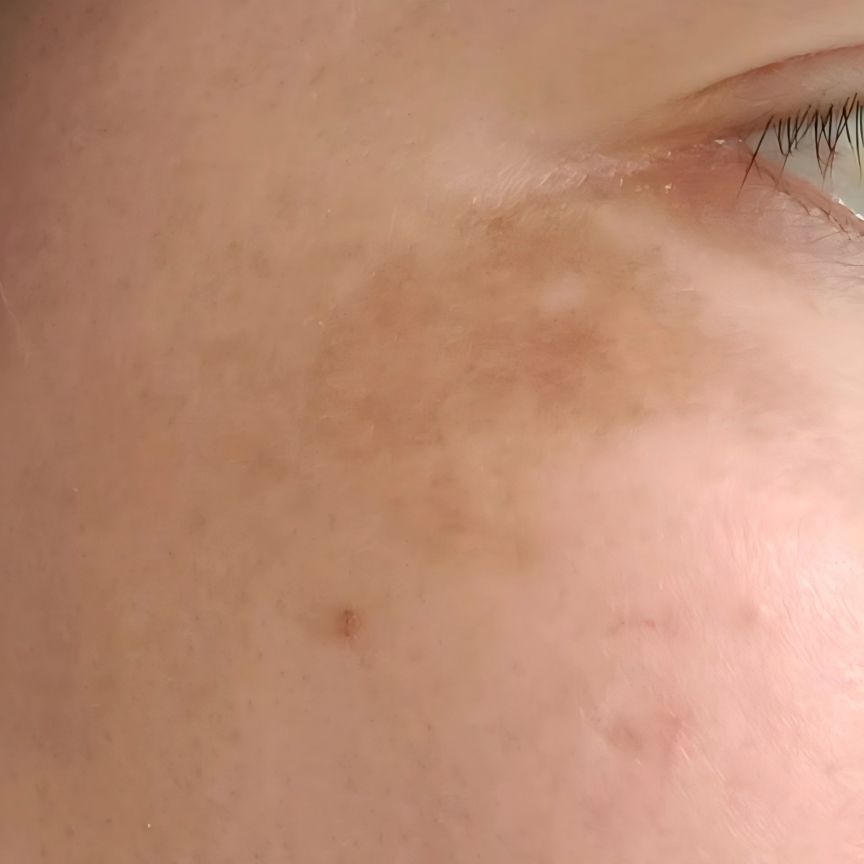
Centella asiatica has been used medicinally for thousands of years. It is mainly used to clear heat and benefit dampness, detoxify and reduce swelling. It can also be used in compound prescriptions to treat damp-heat jaundice and heatstroke diarrhea. Existing studies have shown that Centella asiatica extract has great value in the field of medical cosmetology. Some cosmetics and drugs have already been added with Centella asiatica extract, which has a good anti-aging and redness-reducing effect [1, 23]. In addition to its effect on the skin, Centella asiatica extract also has a positive effect on various tissues and organs throughout the body. Centella asiatica extract can reduce myocardial damage to a certain extent, treat digestive system diseases, protect nervous system activity, enhance cognitive, learning and memory abilities, and may also have anti-tumor effects. Centella asiatica extract can also inhibit bacterial proliferation and has certain antifungal and antiviral effects.
It should be noted that the active ingredients in Centella asiatica extract have a large molecular weight and are not easily absorbed through the normal skin and mucosal barrier, so its scope of application is somewhat limited. Research teams have already developed Centella asiatica glycosides, lipid encapsulation, silica encapsulation, hyaluronic acid encapsulation, etc., to enhance the absorption of Centella asiatica extract by the skin and mucous membranes [35-39]. In addition, there are certain limitations to the use of Centella asiatica as a traditional Chinese medicine. There is some uncertainty about the medicinal properties and efficacy of traditional Chinese medicinal herbs, and there is a risk of contamination during processing and extraction. The safety of their extracts and the chemical processing techniques used need to be further improved. In the future, it is necessary to invest in relevant basic research and clinical trials to conduct more in-depth exploration and lay the foundation for the wider use of Centella asiatica extracts.
References:
[1] Nie Yanfeng. Preparation of Centella asiatica extract and its application in cosmetics [D]. Guangzhou: Jinan University, 2017.
[2 ]SUN B,WU L,WU Y,et al. Therapeutic potential of centella asiatica and its triterpenes:a review[J]. Front Pharmacol,2020, 11:568032.
[3 ]MUSHTAQ Z,IMRAN M,HUSSAIN M,et al. Asiatic acid:a review on its polypharmacological properties and therapeutic po- tential against various Maladies[J]. Intern J Food Propert,2023, 26( 1):1244-1263.
[4] Yang Peilin, Jiang Weizhe, Wu Lingling, et al. Research progress on the pharmacological effects of madecassoside [J]. Shandong Medicine, 2017, 57(17): 102-105.
[5 ]ANWAR A I,ADRIANI A,RIMAYANI S,et al. The effectiveness of galactomyces ferment filtrate,dexpanthenol,and centella asiatica combination serum in the treatment of postacne hyperpigmentation in subjects with skin of color[J]. Skinmed,2021,19 (2):110-115.
[6 ]NIE X,ZHANG H,SHI X,et al. Asiaticoside nitric oxide gel accelerates diabetic cutaneous ulcers healing by activating Wnt/β -catenin signaling pathway[J]. Int Immunopharmacol,2020,79: 106109.
[7] Hong Mengsa. Study on the effect and mechanism of Centella asiatica on HaCaT cells and imiquimod-induced psoriasis mice [D]. Wuxi: Jiangnan University, 2021.
[8 ]KUKULA O,KIRMIZIKAN S,TIRYAKI E S,et al. Asiatic acid exerts an anti-psoriatic effect in the imiquimod-induced psoriasis model in mice[J]. Immunopharmacol Immunotoxicol,2022,44 (3):367-372.
[9] Zhang Qian, Zhang Dong, Wang Li, et al. The effect of a cream containing asiaticoside and 5% panthenol on skin repair after non-ablative fractional laser surgery [J]. Chinese Journal of Aesthetic Medicine, 2022, 28(1): 9-12.
[ 10 ]LICHOTA A,GWOZDZINSKI L,GWOZDZINSKI K. Therapeu- tic potential of natural compounds in inflammation and chronic ve- nous insufficiency[J]. Eur J Med Chem,2019,176:68-91.
[ 11 ]RYALL C ,CHEN S ,DUARAH S ,et al. Chitosan-based mi- croneedle arrays for dermal delivery of Centella asiatica[J]. Int J Pharm,2022,627:122221.
[ 12 ]JU HO P,JUN SUNG J,KI CHEON K,et al. Anti-inflammatory effect of Centella asiatica phytosome in a mouse model of phthalic anhydride-induced atopic dermatitis[J]. Phytomedicine,2018, 43:110-119.
[ 13 ]LEE Y,CHOI H K,N'DEH K P U,et al. Inhibitory effect of centella asiatica extract on DNCB-induced atopic dermatitis in HaCaT cells and BALB/c mice[J]. Nutrients , 2020 , 12 (2):411.
[ 14 ]SHEN X,GUO M,YU H,et al. Propionibacterium acnes related anti-inflammation and skin hydration activities of madecassoside,a pentacyclic triterpene saponin from Centella asiatica[J].Biosci Biotechnol Biochem,2019,83(3):561-568.
[ 15 ]HAFIZ Z Z,AMIN M M,JOHARI JAMES R M,et al. Inhibitory effects of raw-extract centella asiatica(RECA)on acetylcholinesterase,inflammations,and oxidative stress activities via in vitro and in vivo[J].Molecules.2020.25(4):892.
[16] Liang Xia, Chen Zhiying. Observation on the effect of Chinese herbal ointment containing Centella asiatica in the treatment of skin infections [J]. Wisdom Health, 2019, 5(11): 165-166.
[ 17 ]NAMVIRIYACHOTE N ,MUANGMAN P,CHINAROONCHAI K,et al. Polyurethane-biomacromolecule combined foam dress-ing containing asiaticoside:fabrication,characterization and clin- ical efficacy for traumatic dermal wound treatment[J]. Int J Biol Macromol,2020,143:510-520.
[ 18 ]SINGKHORN S,TANTISIRA M H,TANASAWET S,et al. In- duction of keratinocyte migration by ECa 233 is mediated through FAK/AKT,ERK,and p38 MAPK signaling[J]. Phytother Res, 2018,32(7):1397-1403.
[ 19 ]EBAU F,SCANO A,MANCA M L,et al. Centella asiatica ex- tract-SiO2 nanocomposite:more than a drug-delivery system for skin protection from oxidative damage[J]. J Biomed Mater Res A,2023,111(3):300-308.
[20 ]BURANASUDJA V,RANI D,MALLA A,et al. Insights into an- tioxidant activities and anti-skin-aging potential of callus extract from Centella asiatica(L. )[J]. Sci Rep,2021,11( 1):13459.
[21 ]JIANG H,ZHOU X,CHEN L. Asiaticoside delays senescence and attenuate generation of ROS in UV-exposure cells through reg- ulates TGF-β1/Smad pathway[J]. Exp Ther Med , 2022,24 (5):667.
[22 ]PARK K S. Pharmacological effects of centella asiatica on skin diseases :evidence and possible mechanisms[J]. Evid Based Complement Alternat Med,2021,2021:5462633.
[23] Yu Haiyuan. Screening and mechanism of action research on plant-derived anti-aging cosmetic additives [D]. Shanghai: East China University of Science and Technology, 2020.
[24 ]QUILES J,CABRERA M,JONES J,et al. In vitro determina- tion of the skin anti-aging potential of four-component plant-based ingredient[J]. Molecules,2022,27(22):8101.
[25 ]TORBATI F A,RAMEZANI M,DEHGHAN R,et al. Ethnobot- any,phytochemistry and pharmacological features of centella asi- atica:a comprehensive review[J]. Adv Exp Med Biol,2021, 1308:451-499.
[26 ]KONGKAEW C,MEESOMPERM P,SCHOLFIELD C N,et al. Efficacy and safety of centella asiatica(L. )Urb. on wrinkles:a systematic review of published data and network meta-analysis [J]. J Cosmet Sci,2020,71(6):439-454.
[27 ]DU A,ROBERT V,LEE B,et al. Evaluation of the efficacy and tolerance of a facial treatment on subjects with self-perceived sen- sitive skin[J]. J Am Acad Dermatol,2019,81(4):60.
[28] Yang Yong. Exploration of the whitening agent combination for improving skin pigmentation [J]. Fujian Light Industry and Textile, 2020 (7): 43-46.
[29 ]KIM D M,PARK H R,LEE H K,et al. Skin regeneration and whitening effects of the complex extract of dendrobii caulis and centella asiatica[J]. Korean J Pharmac,2022,53(2):70-78.
[30 ]FENG X,HUANG D,LIN D,et al. Effects of asiaticoside treat- ment on the survival of random skin flaps in rats[J]. J Invest Surg,2021,34( 1):107-117.
[31 ]HAWASH A A,INGRASCI G,NOURI K,et al. Pruritus in ke- loid scars:mechanisms and treatments[J]. Acta Derm Venereol, 2021,101( 10):adv00582.
[32 ]HUANG J,ZHOU X,XIA L,et al. Inhibition of hypertrophic scar formation with oral asiaticoside treatment in a rabbit ear scar model[J]. Int Wound J,2021,18(5):598-607.
[33 ]WU X,BIAN D,DOU Y,et al. Asiaticoside hinders the inva- sive growth of keloid fibroblasts through inhibition of the GDF-9/ MAPK/Smad pathway[J]. J Biochem Mol Toxicol,2017,31(8): 21922.
[34] Chen Yang, Xuan Guangshan. Compound Centella asiatica gel patch in vitro transdermal and in vivo scar experiment [J]. Chinese Pharmacist, 2019, 22(8): 1527-1531.
[35] Peng Qian, Xie Wenli, Chen Jingyi, et al. Transdermal properties and mechanism of Centella asiatica glycoside nanomilks and nanomilky gels [J]. Chinese Journal of Traditional Chinese Medicine, 2018, 43(9): 1857-1863.
[36] Xie Shengyang. Preparation of Centella asiatica glycoside porous microspheres and study of their effect on wound repair [D]. Hangzhou: Zhejiang University, 2019.
[37] Xiong Huimin, Yang Xiangguang, Zhang Lin. Preparation and in vitro transdermal study of Centella asiatica glycoside microemulsion gel [J]. West China Journal of Pharmacy, 2019, 34 (1): 27-32.
[38] Yan Hao. Preparation and properties of hydroxycentella asiatica glycoside/acid liposome [D]. Guangzhou: South China University of Technology, 2019.
[39] Chen Yufei, Gao Zongying, Zhang Xuchu, et al. Preparation and in vitro transdermal study of hydroxycentella asiatica glycoside liposomes [J]. Contemporary Chemical Research, 2021 (19): 19-21.


 English
English French
French Spanish
Spanish Russian
Russian Korean
Korean Japanese
Japanese